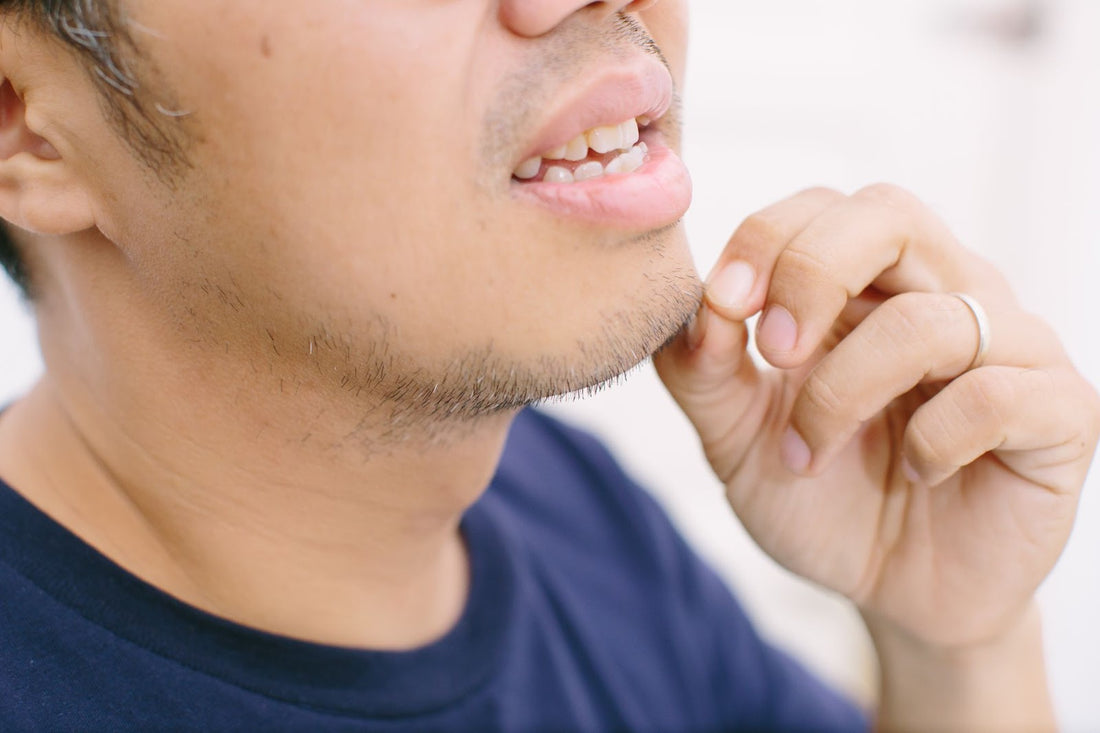Beard picking is an unwanted compulsion that goes beyond grooming. For those caught in the tangled web of this compulsion, the impact stretches far beyond the surface, striking at the very core of self-esteem. It can affect your confidence, ruin social interactions, and strain relationships.
If you suffer from this unwanted and life-interrupting habit, there’s hope for you.
Understanding Beard Picking
At its core, excessive beard picking is a type of Body-Focused Repetitive Behavior, that is, it falls under the category of compulsive behaviors where individuals repeatedly engage in a specific action involving their body. In the case of beard picking, this behavior manifests as the repetitive act of pulling or plucking at facial hair. Body-Focused Repetitive Behaviors (BFRBs) are a group of related disorders that also include hair pulling (trichotillomania) and skin picking (dermatillomania).
Beard picking shares commonalities with other BFRBs, as it often serves as a way for individuals to cope with stress, anxiety, boredom, or other emotional triggers. The act of beard picking may provide a temporary sense of relief or gratification, creating a cycle of repetition that becomes difficult to break without intervention.
Causes of Beard Plucking
Stress and Anxiety
High stress and anxiety levels often trigger beard picking. When stressed, individuals may unconsciously turn to plucking as a coping mechanism. Understanding and managing stress is key to tackling this cause.
Sensory Stimulation
The repetitive act of beard plucking is closely linked to a need for sensory stimulation. Unpacking this means recognizing the satisfaction individuals derive from the tactile feedback, pulling sensation, or sound of plucking. Finding alternative ways to satisfy these sensory needs is crucial in breaking the habit.
Psychological Factors
Exploring the psychological triggers behind beard plucking reveals a complex interplay of emotions. Stress, anxiety, boredom, or a need for emotional regulation can fuel this self-soothing behavior. Identifying these triggers lays the groundwork for targeted interventions like cognitive-behavioral therapy, aiming to break the cycle of beard plucking by addressing its psychological roots.
Is Plucking Beard Hair Bad? Consequences of
Beard Plucking
Skin Irritation
Frequent beard plucking can lead to skin irritation, causing redness and inflammation. The repeated pulling of hair follicles irritates the skin, disrupting its natural balance. This irritation not only affects the visual appearance of the skin but also increases discomfort. Understanding the link between beard plucking and skin irritation emphasizes the importance of adopting strategies to soothe and protect the skin.
Risk of Infection
Compromised skin resulting from beard plucking heightens the risk of infection. Open follicles become susceptible to bacteria, leading to infections such as folliculitis. The constant disturbance of the hair follicles can create an environment conducive to microbial growth. Recognizing the potential for infection underscores the need for preventive measures and proper skincare routines to mitigate this risk.
Impact on Beard Growth
Beyond the immediate effects on the skin, beard plucking can impact the overall growth and appearance of facial hair. The continuous removal of hair follicles disrupts the natural growth cycle, potentially leading to uneven or patchy beard growth. Understanding this consequence emphasizes the long-term aesthetic implications of beard plucking. Individuals grappling with this habit may find motivation in preserving the natural growth and symmetry of their facial hair by addressing the underlying issue.
Social Impact
The physical manifestation of beard plucking, such as noticeable hair loss, patches without hair or skin irritation, can impact social interactions. Individuals may feel compelled to withdraw or avoid social situations due to concerns about how others perceive their appearance. This social impact can lead to feelings of isolation and negatively affect relationships.
Impact on Self-Esteem
The cumulative effects of beard plucking, both physical and psychological, can erode self-esteem. Individuals may struggle with a sense of shame and a diminished sense of self-worth, particularly if they perceive their beard picking as a flaw. Addressing the impact on self-esteem is crucial for fostering a positive self-image and overall well-being.
Managing Beard Plucking
Understanding the causes and consequences of beard picking is only the first step. For those grappling with this BFRB, or those supporting someone who is, effective management strategies are crucial. While shaving the beard may offer a quick recurring solution, for the person that WANTS a beard, further action is warranted. Additionally, shaving the beard - without giving the body and mind a healthier coping mechanism for triggers, will simply move the BFRB to another area, or create a new unhealthy unwanted habit. Here, we delve into actionable steps to break the cycle of beard picking.
Coping Mechanisms
- Stress Reduction Techniques: Equip readers with practical stress-management tools to mitigate one of the primary triggers.
- Cognitive-Behavioral Therapy: Explore how therapeutic interventions can address the underlying psychological factors.
- Seeking Professional Help: Encourage the importance of consulting with professionals specializing in BFRBs for tailored guidance.
Habit Reversal Training (HRT)
Body-Focused Repetitive Behaviors (BFRBs) like beard picking can be treated with techniques like Habit Reversal Training. HRT focuses on increasing awareness of the habit, identifying specific triggers, and replacing compulsive behavior with a more constructive response.
- Awareness Training: The first step in HRT involves becoming more conscious of your beard-picking behavior. The awareness extends to recognizing the situations, emotions, movements, or thoughts that cause the unwanted habit.
- Competing Response: Once aware, you learn to develop a "competing response" to engage in when the urge to pick arises. A competing response is a behavior that is physically incompatible with beard picking, like holding an object, or clasping your hands.
- Social Support and Accountability: Incorporating a social support component into HRT can enhance its effectiveness. Friends, family, or support groups can play a role in reinforcing positive behaviors and providing encouragement during the challenging process of breaking the habit.
HabitAware incorporates HRT principles to aid recovery. Our Keen2 bracelet can be programmed to detect specific movements associated with habitual behaviors like beard picking and sends subtle vibrations to alert you. Our online community provides ongoing motivational support.
Embracing a Journey of Self-Acceptance
While understanding and managing beard picking is essential, it's equally crucial to foster an environment of self-acceptance.
Acknowledging Your Uniqueness
Begin by acknowledging that you are more than the sum of your habits. Embrace the uniqueness that defines you beyond the challenges of beard picking. Understand that quirks and idiosyncrasies contribute to the rich tapestry of your individuality.
Affirming Personal Value
Affirmations are not just words; they are powerful tools to reshape the narrative you tell yourself. Recognize and celebrate your intrinsic value as a person, irrespective of the challenges you may be facing. Repeat positive affirmations that reinforce your worth and strength.
Mindfulness and Self-Compassion
Incorporate mindfulness practices into your daily routine. Mindfulness allows you to observe your thoughts and feelings without judgment, creating space for self-compassion. Treat yourself with the same kindness you would offer to a friend facing a similar struggle.
Setting Realistic Expectations
Understand that the journey of self-acceptance is not a linear path but a dynamic process. Set realistic expectations for yourself and acknowledge that growth takes time. Celebrate small victories, and be patient with setbacks, viewing them as opportunities for learning and resilience
Conclusion
The journey towards overcoming beard picking is personal and unique. Seeking professional guidance and fostering self-acceptance can be transformative steps towards a healthier relationship with oneself.


